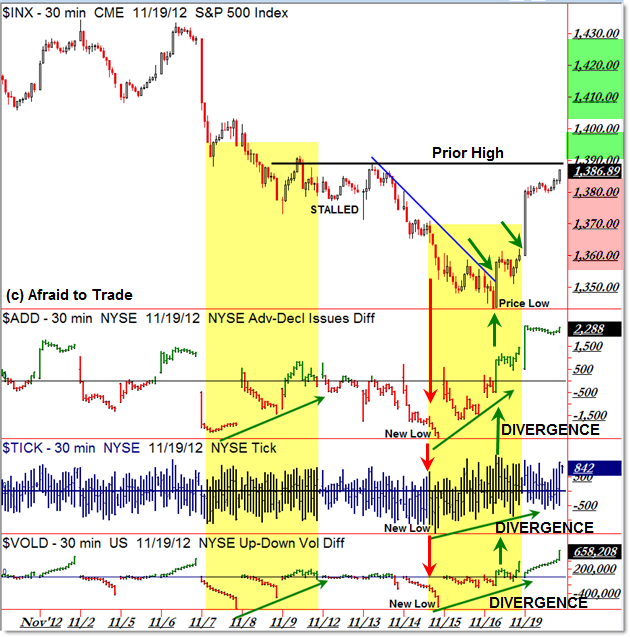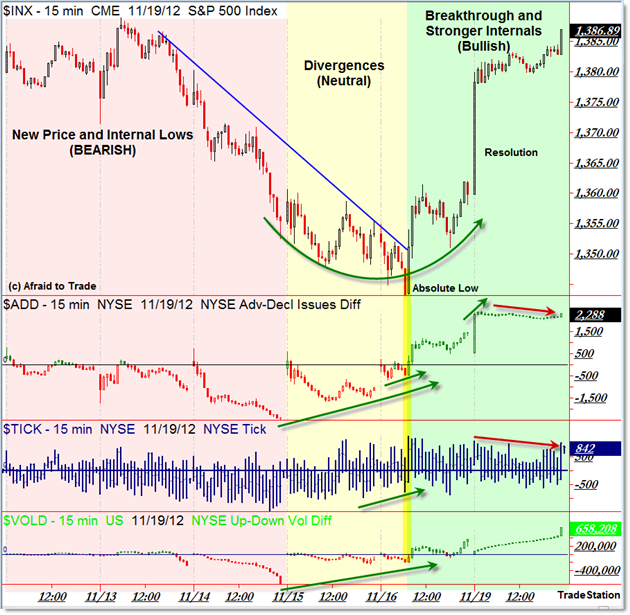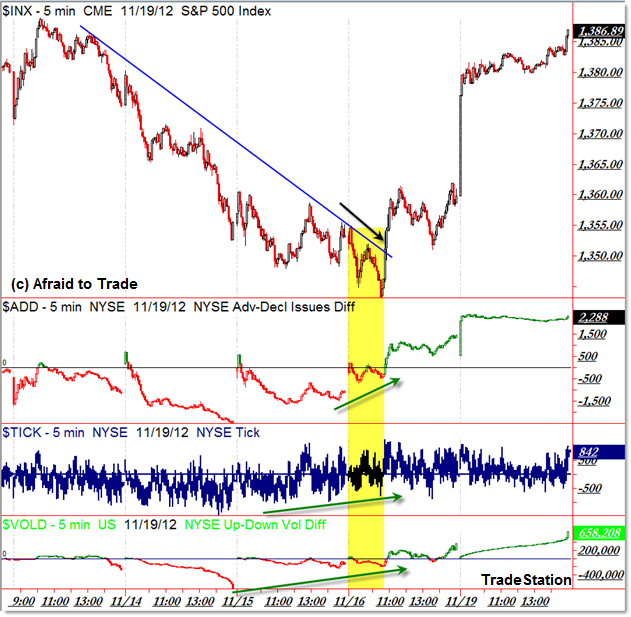Quick Checking SP500 Market Internals to Start Thanksgiving Week
As you’re probably aware, the Thanksgiving holiday week tends to be a bullish week and Monday’s price action may be setting the stage for continued bullishness.
Let’s take a quick look at the S&P 500 “Big Three” Market Internals and note the recent powerful divergence that set the stage for Monday’s big rally.
Here’s the 30-min bigger picture of the S&P 500 and key Market Internals:

For market internals, we use Breadth ($ADD), NYSE TICK ($TICK), and Volume Difference of Breadth ($VOLD).
While Breadth and VOLD reveal wider participation (measuring issues up/positive on the session vs issues down/negative on the session), TICK is a more immediate measure of buying or selling strength/pressure.
We use divergences in conjunction with price to provide clues as to prevailing trend continuity or future trend reversal.
For example:
Price falling to new lows as internals also fall to new lows – this serves as a confirmation and suggests new lows are yet to come (trend continuity).
Price falling to new lows as internals make a series of higher lows – this divergence serves as a non-confirmation and suggests a future reversal may be around the corner.
You can see both of these principles playing out with the new price and internal lows developing on November 7th which suggested further price weakness (new lows) yet to come – and they did.
A similar “new price low and new internal low” situation occurred on November 14th with the final low (so far) occurring on November 16th.
There are two sets of positive divergences on the chart, the first of which stretches from November 8th and 9th which gave rise to a failed reversal and led to a small retracement up only – no reversal.
The most recent set of positive divergences on November 15th and 16th set the stage for Friday’s powerful intraday reversal and the subsequent follow-through in today’s (Monday’s) session.
I like to visualize these concepts on the chart as bullish, bearish, or neutral biases as such:

Bearish zones (or biases) occur when price and internals confirm with new lows appearing in both.
Bullish zones (biases) similarly occur when price and internals both reveal new swing highs together.
Neutral or “potential reversal” zones develop when we see non-confirmations or visual divergences between price and respective internals (or volume or momentum).
I highlighted these on the clearer 15-min chart as red, green, and yellow conceptual zones.
The final chart reveals an even clearer perspective as we step into the 5-min intraday chart:

Pay close attention to the final swing low on Friday, November 16th in terms of the persistently positive divergences in all three Market Internals.
Specifically, if we look at Breadth ($ADD) on November 16th, we see the morning Breadth low was -681 at 9:10am CST when price traded to a new low of 1,345; one hour later at 10:30am CST, Breadth ‘improved’ to -482 as the S&P 500 registered a new session low of 1,343.50.
This is valuable information for intraday and even swing traders to recognize in real-time and examples like these help clarify the concepts when a similar situation will occur.
Ultimately, price did reverse and buyers helped push the market to the present breakthrough and short-term swing reversal.
Which brings us to where we are currently….
While Breadth and VOLD clearly pushed to new recent indicator highs, TICK did not. Neither did volume which was relatively low for today’s session, especially when considering the 27 point SP500 rally.
Yes, odds do seem to favor additional follow-through to the upside especially if price can break above the horizontal resistance into 1,390, but if we do see continued upside action this week, pay very close attention to these key market internals and volume as well for additional signs of possible confirmation.
If we continue to see higher prices on lower internals and market internals as may be the case, then structure will shift back to the “neutral” then likely bearish case.
If so, then the non-confirmation would label this up-move as nothing more than an upward retracement against a prevailing daily chart short-term downtrend and not the start of a bullish trend reversal in motion.
Corey Rosenbloom, CMT
Afraid to Trade.com
Follow Corey on Twitter: http://twitter.com/afraidtotrade
Corey’s new book The Complete Trading Course (Wiley Finance) is now available!

Thanks for all the good lessons Corey.